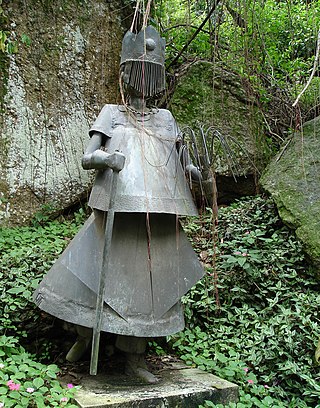Ọya
Spirit of the Yorùbá religion From Wikipedia, the free encyclopedia
Ọya (Yorùbá: Ọya, also known as Oyá or Oiá; Yàńsàn-án or Yansã; and Iansá, Iansã, or Iansan in Latin America) is an Orisha of winds, lightning, and violent storms.[1][2] As a river deity she is also regarded as a deity of children, able to provide children to her devotees or those who come to her banks at the Niger river.
You can help expand this article with text translated from the corresponding article in Spanish. (January 2025) Click [show] for important translation instructions.
|
| Ọya | |
|---|---|
Storms, wind, thunder, lightning, the dead | |
| Member of Orisha | |
 Iansã Sculpture at the Catacumba Park, Rio de Janeiro, Brazil | |
| Other names | Oyá or Oiá; Yàńsàn-án or Yansã; and Iansá or Iansã |
| Venerated in | Yorùbá religion, Umbanda, Candomble, Quimbanda, Santeria, Haitian Vodou, Folk Catholicism |
| Symbol | lightning, the sword or machete, the flywhisk, water buffalo |
| Color | purple or red/burgundy, the rainbow |
| Region | Nigeria, Benin, Latin America |
| Ethnic group | Yorùbá |
| Genealogy | |
| Spouse | Shango |
Beliefs
Summarize
Perspective
Ọya lived on Earth as a human from the town of Ira, in present day Kwara state, Nigeria, where she was a wife of the Alaafin of Oyo, Shango. In Yorùbá, the name Ọya is believed to derive from the phrase coined from "ọ ya" which means "she tore," referring to her association with powerful winds. She was believed to have the power to shape-shift into a buffalo, and is often depicted as one in traditional Yorùbá poetry. As such, the buffalo serves as a major symbol of Ọya, and it is forbidden for her priests to kill one.[3] She is known as Ọya Ìyáńsàn-án, the "mother of nine", because of the nine children she gave birth to with her third husband Oko, after suffering from a lifetime of barrenness. She is the patroness of the Niger River (known to the Yorùbá as the Odò-Ọya).[4]
In the Yoruba religion, Ọya was married three times, first to the warrior orisha Ogun, then Shango, and finally, another hunting and farming deity, Oko.
Oya was traditionally worshipped only in the areas of Yorubaland once under the control and influence of the Oyo Empire. Because of the Atlantic slave trade, many of her followers of Oyo origin were kidnapped and sold to the New World, where her worship became widespread. Oya worship has also spread to other parts of Yorubaland.
Candomblé
Summarize
Perspective
In Candomblé, Oya is known as Oiá, lyá Mésàn, or most commonly, Iansã, from the Yoruba Yánsán. Iansã, as in Yoruba religion, commands winds, storms, and lightning. She is the queen of the river Niger and the mother of nine. She is a warrior and is unbeatable. Attributes of Iansã include great intensity of feelings, sensations, and charm. Another ability attributed to Iansã is control over the mysteries that surround the dead.[5] Iansã is syncretized with Saint Barbara.[6] In the Candomblé nação (association) of Angola Congo, Iansã is associated with the color red.[7]
Characteristics
- Salutation: "Eeparrei!", or "Epahhey, Oia!"
- Consecrated day: Thursday
- Colors: red, purple and rainbow, burgundy
- Symbols: "Buffalo tail" eruquerê, a ritual object; or a copper sword
- Prohibitions: pumpkin, stingray, and mutton
- Food: acarajé/àkàrà[8]
Ritual foods
Acarajé is a spherical patty made with peeled, crushed black-eyed peas, stuffed with small shrimp, okra, crushed peanuts, and other savory, piquant spices. The ball-like patty is fried in dendê oil (red palm oil). It's a traditional Afro-Brazilian dish that is also a traditional offering to Iansã in the Candomblé tradition. A simple, unseasoned form of acarajé is used in rituals and a version served with various condiments is sold as a common street food in Bahia in the northeast of Brazil. Ipeté and bobo de inhame are also associated with Iansã.[7]
In Yorùbá, her food is Àkàrà. Eggplant, mulberries, pudding, and dark chocolate are also foods for Oya.
See also
Bibliography
- Judith Gleason, Oya, San Francisco: Harper, 1992 (Shamballah, 1987), ISBN 0-06-250461-4
- Charles Spencer King, Nature's Ancient Religion, ISBN 978-1-4404-1733-7
References
Wikiwand - on
Seamless Wikipedia browsing. On steroids.
